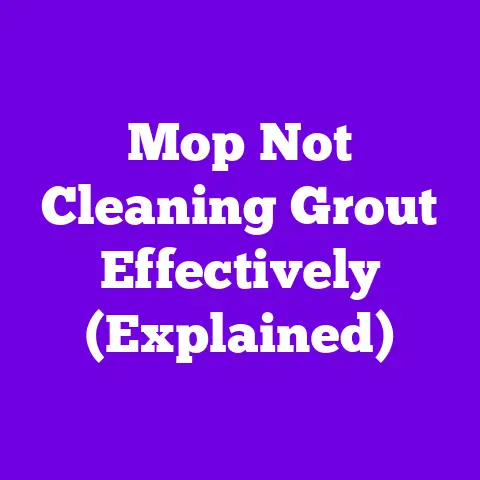Why Fast Drying is Key for Wet Mops (Explained)
When mopping floors, you want to avoid leaving puddles or having damp areas that can lead to mold, mildew, and bacteria growth. Allowing mops to dry thoroughly between uses is crucial. A wet mop left soaking breeds germs and leaves floors slippery.
Drying your mop quickly and properly helps:
- Prevent cross-contamination: From area to area and from day to day use.
- Minimize mold and mildew: Which can discolor floors and impact air quality.
- Reduce bacteria growth: Damp mops allow rapid spread of bacteria.
- Eliminate bad odors: From dirty mop water and bacteria.
- Improve mop lifespan: Trapped moisture damages mop fibers over time.
So how can you ensure your mops dry faster and properly after each use? Follow the tips below for accelerated drying and storage.
Give Mops a Good Initial Wring Out
After mopping, do not just plop them soaking wet into your janitor’s closet! Giving mops a thorough initial wringing helps remove excess water to cut down drying time. Wring in a bucket or utility sink, using a press, mop wringer tool, or even manually twisting. Apply firm pressure, wearing gloves to protect your hands.
Remove as much liquid as possible – at least 75%. This prevents excess dripping onto floors as you transport to storage. It also means less water logged into mop fibers needing to later evaporate.
Tip: Have a designated mop drying area with a drain and wringer hook installed. This lets you properly deal with wet mops after use.
Use a Spinning Centrifugal Mop Bucket
Centrifugal mop buckets with spin dryers built in can remove huge amounts of water in seconds compared to manual wringing. These special buckets have perforated interiors to let water escape as an electric motor spins the mop at high speeds.
The fast mechanical spin forces water out by centrifugal force, without damaging mop fibers. This leaves mops with just 25-30% residual moisture. It makes a massive difference for drying efficiency.
Benefits of Centrifugal Mop Buckets:
- Cut drying times: From 1-2 days to just 4-8 hours on average.
- Lightweight: Easy to transport mops after spinning.
- Water efficient: Reuse extracted dirty water to pre-soak and clean mops. Can also fill with clean water and detergent for auto-dispensing when mopping.
- Labor saving: No strenuous manual wringing needed.
While the motorized buckets have a higher upfront cost, long term they can save hours of effort and make mop drying management much easier. Well worth the investment for most professional cleaning operations.
Use Multiple Mop Heads in Rotation
Rather than repeatedly re-using the same damp mop each day, utilize multiple mop heads in a rotation. This allows each set sufficient drying time while still having a ready mop available for cleaning.
Ideal rotation depends on your specific mopping needs:
- Light daily mopping: 3-4 mops, rotating daily.
- Heavy use/large areas: 5-6 mops, rotating every 1-2 uses.
Store mops suspended vertically in a mop drying cabinet to air dry thoroughly after a spin. Then reuse once fully dry. Having sufficient backups ensures you always have a fresh ready mop.
Benefits of a Rotating Mop System:
- Better hygiene: Fresh mops limit bacterial transfer.
- No mildew smells: Each mop dries out between uses.
- Longer mop lifespans: Fibers don’t stay perpetually damp.
- Consistent cleaning: Clean with fully dried out mops.
Use Microfiber Mop Pads for Fast Drying
Standard cotton yarn mops retain moisture and take over 24 hours hanging to fully dry. Microfiber mop pads dry in a fraction of the time – often under 8 hours. Made from very fine synthetic fibers, microfiber absorbs liquid well but does not hold onto it once wrung out.
The ultra-fine fibers create more surface area for moisture to evaporate. Microfiber is also lightweight. This lets you easily wring it very dry after cleaning. Less retained water translates to speedier drying compared to bulky cotton yarn.
Just beware that microfiber can foster bacterial growth if left wet between uses. So dry thoroughly and wash pads regularly. Microfiber also wears out faster than cotton – plan to replace pads every 6-12 months with heavy use.
Advantages of Microfiber Mop Pads:
- Absorbent: Traps dirt, grease, and liquids during cleaning.
- Fast drying: Just 5-8 hours air dried.
- Reusable: Launder pads for repeated use.
- Economical long term: Despite needing replacement every 1-2 years with heavy use.
Use Synthetic Quick-Dry Mop Yarns
If using a traditional string mop, choose newer generation synthetic yarns designed specifically for fast water release and drying:
- Rayon blend mops: Stronger when wet than 100% cotton. Retains little moisture.
- Polyester blends: Absorb less water than natural fibers.
- Vinyl coated nylon yarns: Repels moisture retention well.
These absorb water initially for cleaning floors effectively. But the synthetic fibers do not hold onto moisture once wrung out. This means faster evaporation compared to soggy cotton mops that take over a day to dry.
The materials are bleach resistant for sanitizing. They also withstand high heat drying to kill bacteria. Just avoid excessive heat levels that could melt fibers.
When buying string mops look for tags like “quick dry” and materials like rayon, polyester blends. Avoid 100% dense cotton.
Use Multiple Mop Handles
Rather than removing mop heads from handles after use, utilize color coded handles dedicated to each mop. This avoids compression of fibers when remounting heads that can impede drying.
Having multiple handles makes rotation systems easier:
- Clearly identify which mops are soiled or drying at a glance.
- Save time not having to detach and re-attach mop heads.
- Avoid damage to fibers from frequent mounting/removal.
- Eliminate compression of fibers around hardware.
- Let gravity aid water release with vertical storage.
Just mark handles clearly to coordinate with color coded mop heads in use. This keeps things easily identifiable when retrieving from drying storage.
Dry Mops Vertically Not Horizontally
Once initially wrung out, hang mops vertically to dry rather than laying horizontally. Vertical hanging allows moisture to drain down through fibers without pooling. Gravity pulls water out for faster evaporation.
Hang in a commercial metal mop drying cabinet if possible. These have slots to separate mops for airflow access to all sides. Ventilation helps moisture release. Storing mops compressed horizontal in a bucket actually inhibits drying and promotes mildew.
Without a special cabinet, affix hooks to a wall spaced well apart. Hang mops fully extended without touching. Keep off floors to avoid reabsorbing moisture or spreading dirt.
Tips for Vertical Mop Drying:
- Face mops inward: So dirty exterior fibers don’t contact wall. Insert with handle tops facing down.
- Space at least 8 inches apart: Avoid bunching or cramming together.
- Designate soaked and dry sides: Flip positions each load so pads alternate drying completely.
- Dry thoroughly between uses: 48-72 hours optimal for cotton yarn mops.
Proper vertical air drying avoids bacteria issues and extends mop lifespan.
Use a Disinfectant Laundry Rinse or Dryer
For microfiber pads or reusable string mops, machine washing alone does not fully sanitize. To kill bacteria and eliminate odors that impede drying, use a disinfectant laundry rinse in each load.
Or if washing in industrial machines, run mops through high heat dryer cycles to disinfect. Heat over 160°F helps kill bacteria. Just avoid excessive temperatures that could melt synthetic mop fibers.
Bleach can damage some materials. But hospital grade disinfectant laundry additives avoid wear and tear while still sanitizing. Killing odor causing germs helps freshly cleaned mops dry faster without retaining bad smells.
Disinfectant Washing Tips:
- Shake out dried debris first: Before washing. Reduces rinse cycles needed.
- Use proper detergent: Formulated for microfiber or cotton yarn per label guidelines.
- Extra rinse cycle: Removes all residual detergent to prevent stickiness.
- Disinfectant additive: Kills germs and eliminates odors.
- Air dry: Heat drying can damage cotton yarns long term.
Proper cleaning is essential for fast drying and preventing sour mop odors.
Use an Accelerated Electric Mop Dryer
Electric mop dryers can completely dry all types of mops under an hour. Enclosed cabinets with heating elements, fans, and dehumidifiers circulate hot air to rapidly extract moisture. Much faster than ambient air drying that takes hours.
Simply hang freshly wrung mops inside on racks, set a timer, and turn on the dryer. Mops come out ready for immediate reuse.
Look for heavy duty models made of stainless steel. Seek additional features like:
- UV sterilization: Kills bacteria.
- Ozone deodorizer: Removes odors.
- High capacity: For facilities with numerous mops.
- Caster wheels: Easy mobility.
Electric dryers have higher upfront investment but provide immense long term labor savings. Well worth costs for most cleaning pros or high traffic facilities.
Frequently Asked Questions
What are signs a mop needs replacing?
Retire mops once fibers appear worn, frayed, discolored, take over 48 hours to dry, or emit foul odors. Stiff, flattened strands also indicate replacement needed.
Can I put wet mops in a clothes dryer?
Not recommended. Home dryers can damage mop fibers not designed for tumbling heat drying. Best to use spin buckets then air or cabinet drying.
Where should I dry mops?
In a ventilated mop drying cabinet ideally. Or hang on hooks spaced well apart along a wall near storage. Never leave soaking wet in buckets.
How do I clean microfiber mop pads?
Machine wash after each use with proper microfiber detergent. Do an extra rinse cycle. Use a disinfectant additive or high heat drying monthly to kill bacteria.
What temperature water should I use for mopping?
Aim for lukewarm 80-100°F water. Avoid extremely hot water that can damage fibers. Very cold water is less effective at grease cutting. Warm water also helps soaked mops dry out faster.






